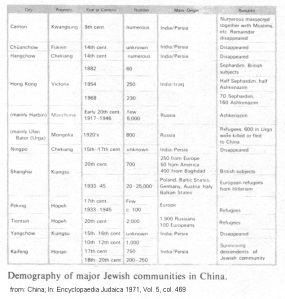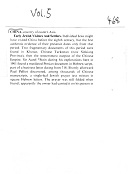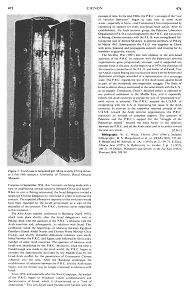<CHINA, country of eastern Asia.
Early Jewish Visitors
And Settlers.
Individual Jews might have visited China before the
eighth century, but the first authentic evidence of
their presence dates only from that period. Two
fragmentary documents of this period were found in
Khotan, Chinese Turkestan (now Sinkiang Province), then
the westernmost outpost of the Chinese Empire. Sir Aurel
*Stein during his explorations here in 1901 found a
mutilated Persian document in Hebrew script, part of a
business letter dating from 718. Shortly afterward Paul
Pelliot discovered, among thousands of Chinese
manuscripts, a single-leaf Jewish prayer text written in
square Hebrew letters. The prayer was still folded when
found; apparently the owner had carried it on his person
in (col. 468)
this way. Both Jewish visitors probably arrived by
caravan from or via Persia across Central Asia.
While these visitors traveled by land, other Jews
arrived in China by sea along the Muslim trade route to
the southern Chinese port of *Canton, Kwangtung
Province. There, during a rebellion in 878-79 some
120,000 Muslims, Jews, and other foreigners are said to
have been massacred.
The Jews who entered Khotan and Canton may never have
had an opportunity of seeing the interior of China.
Their stay was temporary and they exercised no lasting
influence. Reports that there were other Jewish
communities in Chüanchow (Zayton), Fukien Province, and
Ningpo, Chekiang Province, may be true, but cannot be
corroborated.
[Jewish immigrants
speaking Persian - professions and products - Mongol
rule]
Under the declining Sun Dynasty a cohesive Jewish group
of some 1,000 people, including women and children,
settled in the ninth or tenth century at the invitation
of the emperor in *Kaifeng, capital of Honan Province.
They spoke New Persian and arrived from either India or
Persia. Some 250 of their descendants, whose Jewishness
has been lost through intermarriage, are still living in
Kaifeng. By profession the original settlers were
specialists in the manufacture, dyeing, or
pattern-printing of cotton fabrics. This industry was
then being developed in China to meet the chronic silk
shortage.
Additional information is available regarding Jews in
China under the Yüan Dynasty. Marco Polo, who visited
China toward the end of the 13th century,
[[according to the latest research Marco Polo is an
invention]]
reported that Jews, Muslims, and Christians were
disputing the advantages (col. 469)
of their respective religions before the Mongol
conqueror and his court.
Moreover, three decrees pertaining to Jews were issued
in China under Mongol rule, indicating that the number
of Jews in China at that period must have been sizable:
(1) "Christians, Jews, and Mohammedans shall be taxed as
before..." (1329)
(2) *levirate marriages (Halizah) were prohibited (1340); these
were practiced among Jews and Muslims, but were an
abomination in the eyes of the Chinese, Mongols, and
Manchus; and
(3) wealthy Muslims and Jews were summoned to the
capital to join the army (1354).
no new Jewish communities were formed in China until the
middle of the 19th century.
Modern Jewish
Communities.
[Jews in China
1840-1937 - numbers]
Jews settled in China from the 1840s with the cession of
*Hong Kong to Great Britain and the establishment of
foreign concessions in *Shanghai, *Tientsin, and other
cities. In Hong Kong the Jews were predominantly British
subjects. Many of them went there from India and Iraq.
By 1937, about 10,000 Jews were living in China. Some
2,000 lived in Shanghai, consisting of about 1,000 of
various European nationalities (250 old-timers and 750
early refugees from Nazism); some 500 from Russia; some
400 British subjects, mostly from India and Iraq; and
some 50 from America.
Tientsin had a Jewish population of about 2,000, about
half of whom were of Russian origin, the remainder of
various European nationalities. The Russian-Jewish
population in *Harbin amounted to some 5,000 people, not
counting small Jewish communities in other Japanese
occupied Manchurian cities, especially Dairen. Most of
these Russian Jews were refugees from the Russian
Revolution of 1917.
[Jewish refugees from
NS Germany in Japanese Shanghai - Japanese Jews
deported to Shanghai]
The greatest influx of Jews in China was, however,
caused by Hitlerism. Some 18,000 to 20,000 victims of
Nazism found a precarious shelter in Japanese-occupied
(col. 470)
Shanghai between 1938 and 1941. After the outbreak of
war in the Pacific in 1941, the Japanese deported their
own Jewish community via *Yokohama to Shanghai.
Transient Jewish refugees from Europe on their way to
other parts of the world, who were stranded in Japan due
to the outbreak of the war, suffered the same fate.
Thus, on the eve of the Pacific War a total of between
25,000 and 30,000 Jews were living in China, including
*Manchuria.
[Jewish emigration
after 1945 - Russian Jews have to return to Stalin's
terror Russia]
After the end of World War II the Jews in China, most of
whom were living under miserable conditions in Shanghai,
were given an opportunity to proceed to other parts of
the world, largely with American aid. Russian Jews were
urged by diplomatic representatives of the Soviet Union
to return to that country. Those Jews of Russian origin
who were unable to reach North or South America, Israel,
or other countries automatically had to return to the
Soviet Union. Practically all the Russian Jews in
Manchuria were in this position, because Manchuria was
cut off from the rest of the country by civil war.
A few elderly Jewish residents without families were
allowed to live out their days in Shanghai. Neither the
Nationalist Chinese Government on Formosa (Taiwan), nor
the Chinese People's Republic on the mainland have any
diplomatic relations with Israel. At present there are
virtually no Jews living in China except in Hong Kong.
See also *Ai Tien, *Chao, *Hangchow, *Ningpo, and
*Mongolia.
[R.L.]
Table.
Jews in China
|
xxxxxxYearxxxxxx
|
number of Jews
|
xsourcex
|
remark
|
9th-10th century
|
1,000
|
col. 469 |
Sun Dynasty
|
1937
|
about 10,000 xxxxxx
|
col. 470
|
2,000 in
Shanghai:
250 old-timers
750 early refugees from Nazism
some 500 from Russia
some 400 British mostly from Indian and Iraq
some 50 from "America"
2,000 in Tientsin:
about 1,000 from Russia
the rest with various European nationalities
5,000 in Harbin (all Russian Jews)
further small Jewish communities in Manchurian
cities, above all Dairen.
Most of these Russian Jews were refugees from
the Russian Revolution of 1917.
|
1938-1941
|
+ 18-20,000
|
col. 470
|
Jewish refugees
from NS Germany
|
1941
|
25-30,000
|
col. 471
|
including
Manchuria
|
1941
|
+ x
|
col. 471
|
Japanese Jews and
Jewish refugees in Japan deported to Shanghai
|
Table by Michael Palomino; from: China;
In: Encyclopaedia Judaica 1971, vol. 5, col.
470-471
|
Table. Jews in
China according to the different towns and
regions
|
City
|
Province
|
Year or Century
|
Number
|
Main Origin
|
Remarks
|
Canton
|
Kwangtung
|
9th cent.
|
numerous
|
India/Persia
|
Numerous
massacred together with Muslims etc.,
Remainder disappeared
|
Chüanchow
|
Fukien
|
14th cent.
|
unknown
|
India/Persia
|
Disappeared
|
Hangchow
|
Chekiang
|
14th cent.
|
numerous
|
India/Persia
|
Disappeared
|
Hong Kong
|
Victoria
|
1882
|
60
|
|
Sephardim,
British subjects [[from Indian, Iraq]]
|
|
|
1954
|
250
|
India/Iraq
|
Half Sephardim,
half Ashkenazim
|
|
|
1968
|
230
|
|
70 Sephardim,
160 Ashkenazim
|
(mainly Harbin)
|
Manchuria
|
Early 20th cent., 1917-1946
|
few 5,000
|
Russia
|
Ashkenazim
|
(mainly Ulan
Bator (Urga)
|
Mongolia
|
1920s
|
800
|
Russia
|
Refugees, 600
in Urga were killed or fled to China
|
Ningpo
|
Chekiang
|
15th-17th cent.
|
unknown
|
India/Persia
|
Disappeared
|
Shanghai
|
Kiangsu
|
20th cent.
|
700
|
250 from
Europe, 50 from America, 400 from Baghdad
|
British
subjects
|
|
|
1933-45
|
20-25,000
|
Poland, Baltic
States, Germany, Austria, Italy, Balkan States
|
European
refugees from Hitlerism
|
Peking
|
Hopeh
|
17th cent.
|
Few
|
Europe
|
|
|
|
1933-1945
|
c. 100
|
Europe
|
Refugees
|
Tientsin
|
Hopeh
|
20th cent.
|
2,000
|
1,000 Russians,
100 Europeans
|
Refugees
|
Yangchow
|
Kiangsu
|
15th-16th cent.
|
unknown
|
India/Persia
|
Disappeared
|
|
|
10th-12th cent.
|
1,000
|
|
|
Kaifeng
|
Honan
|
17th cent.
|
750
|
India/Persia
|
Surviving
descendants of Jewish community
|
|
|
18th-20th cent.
|
200-250
|
from: China; In:
Encyclopaedia Judaica 1971, vol. 5, col. 469
|
China and [[Herzl]]
Israel.
[1950: Herzl Israel
recognizes Mao's terror China]
Relations between the People's Republic of China
(P.R.C.) and Israel evolved mainly around the
question of establishing diplomatic ties between the
two countries. Israel was among the first group of
countries, outside the Communist bloc, that
recognized the P.R.C. This recognition was granted
in January 1950 and resulted in the formal severing
of relations between Israel and the Republic of
China (Taiwan).
In the first years after its establishment, the
P.R.C. displayed a desire to set up full diplomatic
relations with Israel. The factor of Arab hostility
toward Israel did not yet play a role in Communist
China' consideration of this question since, in the
early 1950s, the P.R.C. envisioned no strong
possibilities of establishing firm ties with the
Arab states, which were then mostly monarchical and
strongly attached to the West and to what China
considered the reactionary camp.
The next step, however, namely the establishment of
diplomatic relations with Israel, by means of mutual
representation, suffered a setback because of the
involvement of the P.R.C. in the Korean War and the
prohibitive attitude of the United States toward the
question of diplomatic relations between any country
and government in Peking.
[[By this connection can see that Herzl Free Mason
CIA Israel is only a puppet state of the "USA"]].
[1955: Jewish
delegation visiting China]
After contacts were made in various parts of the
world between the representatives of Israel and
those of the P.R.C., and especially the contacts
between the Israel minister in Rangoon, David
Hacohen, with his Chinese counterpart, an Israel
delegation, which was defined as a trade and
goodwill delegation, was invited to visit China.
Headed by David Hacohen, it visited China from Jan.
31 to Feb. 19, 1955, and held talks with the heads
of the Chinese Foreign Office and economic
officials. Its function was to examine closely the
possibility of developing trade relations and the
subject of establishing diplomatic relations between
the two countries.
Even before the delegation's visit, but in light of
contacts maintained at that time between the Israel
representative and those of the P.R.C., an
announcement was made by Chinese prime minister and
foreign minister Chou En-Lai, at the meeting of the
first National People's (col. 472)
Congress in September 1954, that "contacts are being
made with a view to establishing normal relations
between China and Israel."
When its visit in Peking terminated, the Israel
delegation invited a reciprocal Chinese delegation
to visit Israel in order to continue the contacts.
The expected affirmative response to this invitation
would have been regarded by the Israel government as
a sign of the mutuality of the contacts. The P.R.C.,
however, never responded to this invitation.

Encyclopaedia Judaica 1971: China, vol. 5,
col. 469, table with the Jewish settlements
in China,
demography of major Jewish communities in
China |
[since 1955: China
establishing diplomatic relations with Arab
countries - communist influence in Arab states
- Herzl Israel is "out"]
The Afro-Asian summit conference in Bandung
(April 1955), which took place shortly after the
Israel delegation's visit in Peking, dealt with
the question of the P.R.C.'s relations with the
Arab countries and, subsequently, its relations
with Israel. This conference noted the
beginnings of relations between Egyptian
President Gamal Abdul Nasser and Chinese Prime
Minister Chou En-Lai, and shortly thereafter
diplomatic relations were established between
the P.R.C. and Egypt, later followed by Syria
and a number of other Arab countries.
The question of relations with Israel was
abandoned by the P.R.C. Moreover, since the time
a breakthrough was made to the Arab world, the
P.R.C. began to consider the opportunities
provided by the Middle East by the Israel-Arab
conflict for the penetration of Communist
Chinese influence into the area. After the
Bandung conference the establishment of
relations between the P.R.C. and the Arab states
began, and the former was no longer interested
in relations with [[Herzl]] Israel.
From 1956, and especially after the Sinai
Campaign, the leaders of the P.R.C. began to
broadcast violent condemnations and
denunciations of Israel, which it characterized
as a "tool of imperialism". [[This is the
correct prescription for the Herzl program, but
China for itself had committed a mass murder
holocaust concerning the "Big Step Forward" and
did not resolve it's problems...]].
This anti-Israel stand became even harsher with
the (col. 473)
passage of time. In the mid-1960s, the P.R.C.'s
concept of the "war of national liberation"
began to take root in some Arab states -
especially in Syria - and Communist China
reciprocated by expressing its support for every
anti-Israel Arab action.
[China
recognizing PLO - China supporting PLO with
weapons, money, and propaganda support against
the imperialist Herzl Free Mason CIA Israel
puppet state of the "USA" for a victory of the
PLO]
After its establishment, the Arab terrorist
group, the Palestine Liberation Organization
(P.L.O.), was recognized by the P.R.C. and was
active in Peking. Chinese contacts with the
P.L.O. were strengthened following the visit of
Ahmed Shukeiry, its general secretary, to Peking
in March 1965. Subsequently the P.L.O. was
supplied by China with arms, financial and
propaganda support, and training for its members
in guerrilla warfare.
The Six-Day War (1967) lent new impetus to the
anti-Israel activities of the P.R.C.
[[The 10,000s of Palestinians driven away by the
Jewish Herzl army are not mentioned]].
Its relations with the Palestinian terrorist
organizations grew progressively stronger, and
it supported any extreme force in the area. At
the beginning of 1970, the chairman of the
executive committee of the P.L.O. and leader of
al-Fatah, Yasser Arafat, visited Peking and was
received there with the honors and diplomatic
privileges accorded to a representative of a
sovereign state.
The P.R.C. regards the war of the Arab states
against Israel as part of the worldwide
anti-imperialist struggle. The State of Israel
is almost always mentioned in the same breath
with the U.S., as its puppet [[and this is
right. But communism in China is not at all
better at this time with the "cultural
revolution"...]]
Communist China's declared policy is opposed to
any political settlement in the Middle East, and
it repeatedly exhorts the Arab countries to
pursue the way of "protracted war" until victory
is achieved. [[Human rights would be the
victory]].
The P.R.C. accused the U.S.S.R. of cooperating
with the U.S. in frustrating the cause of the
Arab countries. In contrast to the somewhat
reserved attitude of the U.S.S.R. toward the
Arab terrorist organizations, the P.R.C.
maintains an attitude of complete support. The
question of Palestine and the P.R.C.'s support
for the "struggle of the Palestinian people"
became the basic factor in the relations between
the P.R.C. and all the Arab states and in its
policy toward the area as a whole.
[[Human rights would be the victory]].
Bibliography
-- W.C. White: Chinese Jews (1966), includes
bibliography
-- D.S. Margoliouth et al., in: JRAS (1903),
735-60
-- P. Berger and M. Schwab, in: JA, 1 (1913), pt.
2, 139-75
-- E. Ezra: Chinese Jews (1925)
-- S. Rabinovitz, in: Gesher, 3 pt. 2 (1957),
108-21
-- H. Dicker: Wanderers and Settlers in the Far
East (1962)
-- Shunami, Bibl. 389-90> (col. 474)







